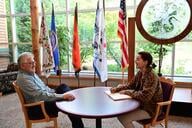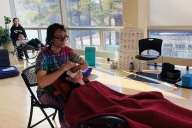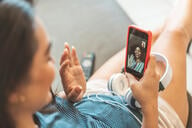You have /5 articles left.
Sign up for a free account or log in.
Test and trace, test and trace, test and trace.
So goes nearly every college announcement that campus will be open for students in the fall.
"We intend to know as much as possible about the viral health status of our community," Mitch Daniels, Purdue University's president, wrote in a letter to the campus community announcing an intention to reopen. "It will include a robust testing system during the school year."
"Testing is an absolute prerequisite," wrote Brown University president Christina Paxson in a New York Times op-ed. "All campuses must be able to conduct rapid testing for the coronavirus for all students, when they first arrive on campus and at regular intervals throughout the year."
The American College Health Association included in guidelines to institutions that a "return to an active on-campus environment will depend upon widespread testing, contact tracing and isolation/quarantine of ill and exposed individuals both on campus and in the community."
But can colleges get access to the those diagnostic tests, or even afford them? The answer is complicated.
Earlier this year, as the pandemic was making silent headway into American bloodstreams, the testing regimen in the U.S. was obviously not optimal. The Centers for Disease Control and Prevention first sent out faulty tests, and then none at all.
Craig Roberts, an epidemiologist emeritus at the University of Wisconsin at Madison, a consultant for ACHA and a member of its COVID-19 task force, said capacity to test has grown since that time, and for the most part should not be an issue for colleges in the fall.
"Before you can reopen, in this case, a university, they have to have the capacity in place to provide diagnostic testing for students, staff and faculty," he said. "You need to make sure that if someone is experiencing any symptoms of COVID that they can get tested immediately."
He added that "in most areas of the country, most jurisdictions, that kind of testing capacity is already beginning to happen and probably by fall will be such a common thing that it will be simple. In fact, it will be that many local public health departments are offering testing on a daily basis."
A large outbreak could still overwhelm a system, he said, but that's where state and local health officials would step in to help.
Dr. Michael Diechen, associate vice president of student health services at the University of Central Florida and also a member of ACHA's task force, said diagnostic testing capacity isn't a major concern in his area.
"Testing capacity has been expanding nicely in the United States. Certainly in Florida, where UCF is located, we seem to have ample testing," he said. Whether availability of tests is sufficient is measured by the percentage of tests that come back positive, with a rule of thumb being under 6 percent is better. Where UCF is located, that number is 1 to 2 percent, he said.
"Assuming things stay as they are over the summer, that will be fine," he said.
Roberts said that small colleges with small student health centers may need to partner with health-care organizations, systems or local agencies, in order to not be overwhelmed by testing. Many college administrations have indicated that is what they intend to do.
At UCF, Dr. Diechen said the university has a community partner that has set up drive-through testing.
Calvin University, located in Grand Rapids, Mich., is another college that has chosen to partner with a health-care company -- in this case Helix Diagnostics -- to help with testing.
"I'm just not seeing enough to tell me that the government at the county or state level is really prepared to do the contact tracing and testing on a scale that is needed," said Michael Le Roy, Calvin's president. "We know that more tests are available now, but as workplaces ramp back up and many companies are doing this kind of testing, and as some educational institutions are going to be doing this kind of testing, the demand for it in the short run isn't going to go away."
Le Roy also said creating a partnership now allowed Helix to develop capacity and get supplies and labor in order.
The university will have 5,000 tests for about 4,000 students and staff members. Students and staff will be tested as they arrive to campus, with 1,000 additional tests left for the semester.
There's no easy answer to how many tests each college is going to need, said Roberts. Similarly, how many rooms for quarantine and isolation a college will need to set aside is also difficult to say.
"You might have one case this semester or you might have 1,000," he said.
The idea of testing before arrival or testing everyone once per week is common in other college plans, but Roberts said that might not be the best use of resources.
"I have not seen any standardized recommendations from the CDC or state health departments for doing mass testing of any community," he said. "It doesn't make a lot of sense to me to do mass testing of an entire population when that population is re-exposed on a daily basis."
Resources might be better spent on contact tracing and quarantine capacity, he said.
But Le Roy said that with the symptoms of COVID-19 often being minimal in the 18- to 22-year-old age group, not prescreening could be inviting trouble.
Dr. Diechen said UCF is looking at prescreening all students who live in residence halls, and potentially including athletes and students who arrive from hot-spot areas.
"Just detecting one person can prevent an outbreak," he said.
ACHA guidelines similarly call for contact tracing, which Le Roy said hasn't been nailed down for Calvin, although the university is working on it.
Roberts said residence halls are likely to be a bigger issue for colleges. ACHA guidelines call for each student to be placed in a private room, ideally with a private bathroom as well, which many colleges are not set up to provide. Those that do have the inventory have stressed private rooms will be provided, while others are looking for creative solutions, such as procuring temporary housing. That's not even to mention what happens when students will inevitably need to be quarantined.
"Often in this field we compare residence halls to cruise ships," Roberts said.
If there is an issue with testing, he said, it is unlikely to be a capacity issue and more likely to be a financial one. His own institution, the University of Wisconsin, had previously said testing would cost about $20 million for one round of testing. Timothy White, chancellor of the California State University system, said that to test half the system's students once a week would cost $25 million weekly, too much for the system to bear.
"We're figuring it out as we go," said Roberts. "There's not a given playbook we can work off of."




